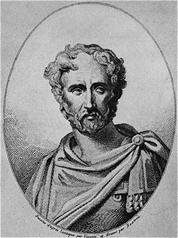Hyena Hybrids
Family Hyaenidae
Mammalian Hybrids
EUGENE M. MCCARTHY, PHD GENETICS, ΦΒΚ
|
The hyena conceives by a wolf and brings forth Onolysum.
—Conrad Gesner
|
Evidence for the occurrence of hyena hybrids is sparse, as the reader will judge from the information below.
Crocuta crocuta [Spotted Hyaena] Lönnberg (1908) treated two forms of hyena as distinct species under two distinct scientific names. As Theodore Roosevelt and Edmund Heller (1914, pp. 261-262) note, “One of these names, kibonotensis, he [i.e., Lönnberg] applied to a reddish animal having a short tail, the other, panganiensis, to a grayish one with a longer tail. These two color and tail extremes, together with every intermediate stage, are represented in specimens from the Loita Plains and the Uasin Gishu Plateau in the National Museum collection. They will be found to occur in any large series from any locality throughout the distribution of this hyena and are to be regarded simply as evidence of the variability of the race.” Due to this evidence of interbreeding, Hollister (1918, p. 144) lumped the two under Crocuta crocuta.
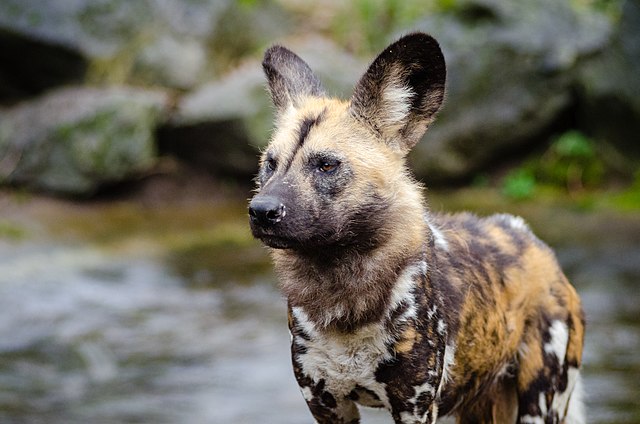 African Wild Dog (Lycaon pictus). A dog-hyena hybrid?
African Wild Dog (Lycaon pictus). A dog-hyena hybrid?
Hyaena sp. [Hyena]
× Canis sp. [Canid] The African wild dog (Lycaon pictus) was originally classified as a hyena (Hyaena pictus Temminck 1820, p. 10), but later reclassified as a dog, although in its own genus, Lycaon. This sort of waffling on the part of taxonomists often presages a later recognition that the organism in question is actually derived from hybridization between the two types of animals between which the vacillation occurs. The highly variable coat coloration of this animal is also suggestive of hybrid ancestry, as Nowak (1999, vol. I, p. 676) states, "There is great variation in pelage, the mottled black, yellow, and white occurring in almost every conceivable arrangement and proportion." However, L. pictus is generally thought to be a non-hybrid canid, and not any more closely related to hyenas than are other animals classified as canids.

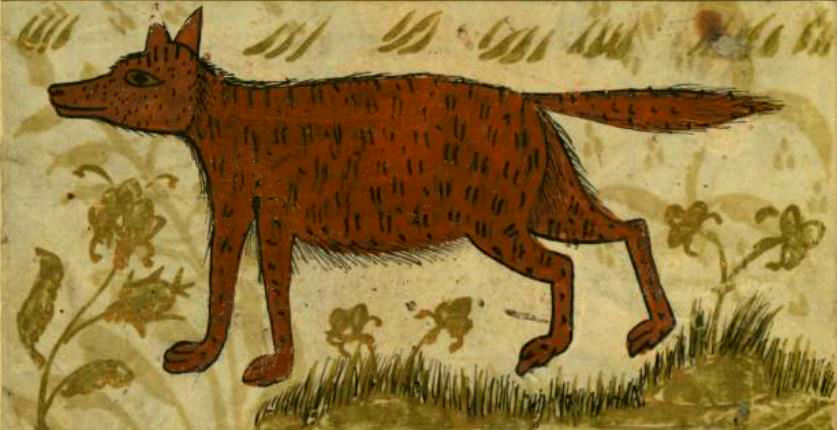 A supposed wolf-hyena hybrid, as pictured in a 13th century bestiary by Zakariya al-Qazwini (Walters MS 659).
A supposed wolf-hyena hybrid, as pictured in a 13th century bestiary by Zakariya al-Qazwini (Walters MS 659).
Note:The Striped Hyena would have been the only hyena known to the ancient Greeks and Romans, for which reason the following three crosses are listed under the heading of that animal.
Hyaena hyaena [Striped Hyena]
× Canis familiaris [Domestic Dog] This cross is listed in early texts, but is not substantiated by any reliable modern report. Nott (1856, p. 495) states that the dog produces hybrids with the hyena, “but to what extent has not yet been determined.” However, he provides no citation, and this cross does not appear to be substantiated by any reliable report, although it is mentioned by various early writers (e.g., Julius Caesar Scaliger 1612, p. 648). Hyenas, along with foxes, wolves and jackals, do figure in the speculations of various authors concerning the origins of the domestic dog. Johann Friedrich Blumenbach (1776, p. 9) notes that Bochart (1663, p. 832) suggested that the Golden Jackal (Canis aureus) was a product of this cross.
× Canis lupus [Wolf] This cross is listed in early texts, but is not substantiated by any reliable modern report. Conrad Gesner (1560, p. 78) says, “The hyena conceives by a wolf and brings forth Onolysum, as it is pronounced (it is written Monolycum), which lives not in a herd but as a solitary, and wanders among men and flocks, as a Greek wrote recently, who attributes to him indeed rough thick hair: and without neck vertebrae and stiffened in one upright bone” (translated in Zirkle 1935, p. 34).
× Panthera leo (♀) [Lion] Ancient authors mention this cross, but such claims have not been substantiated by any reliable modern report. Pliny the Elder (Naturalis Historia, VIII, xlv) relates an ancient myth, saying that when a lioness is crossed with a hyena, it “gives birth to the corocotta, that mimics the voices of men and cattle. It has an unbroken ridge of bone in each jaw, forming a continuous tooth without any gum, which, to prevent its being blunted by contact with the opposite jaw, is shut up in a sort of case” (Rackham 1961).
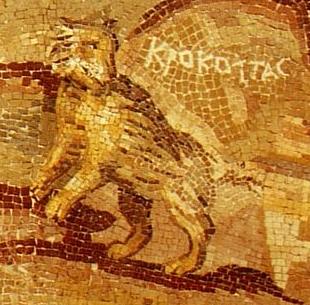 An ancient depiction of a corocotta. Detail from the Nile Mosaic, Museo Nazionale Palestrina, Italy.
An ancient depiction of a corocotta. Detail from the Nile Mosaic, Museo Nazionale Palestrina, Italy.
By the same author: Handbook of Avian Hybrids of the World, Oxford University Press (2006).
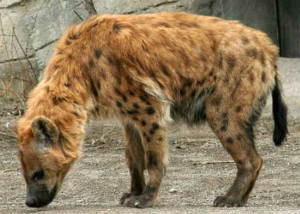
 Scaliger
Scaliger Blumenbach
Blumenbach
